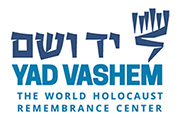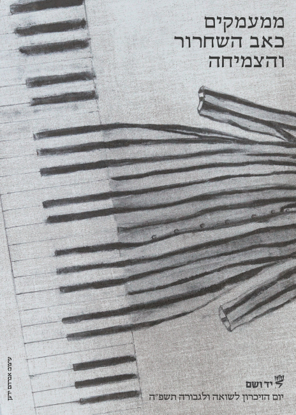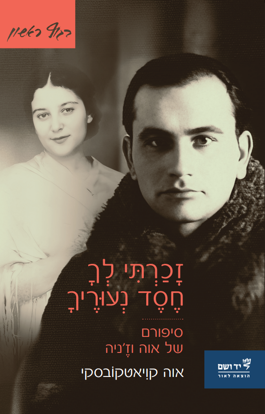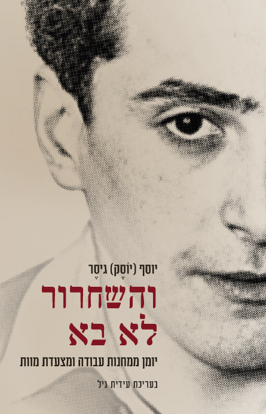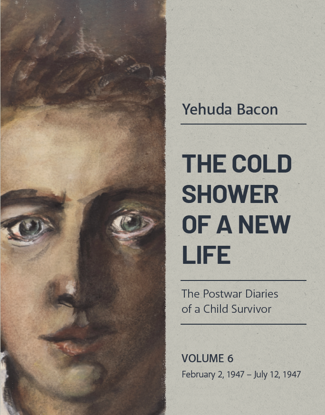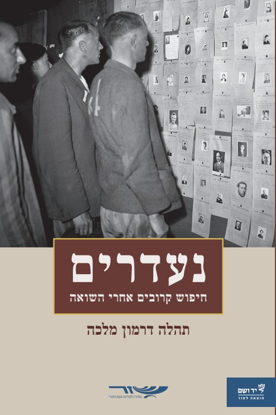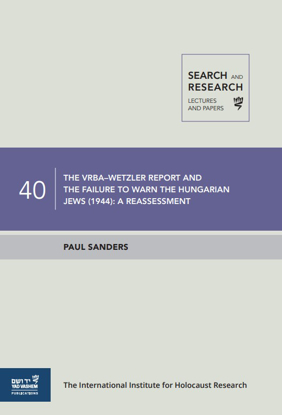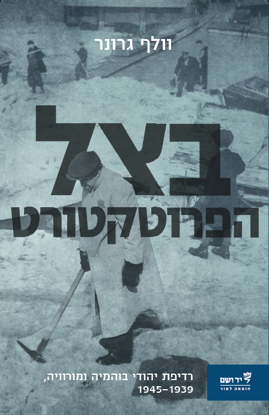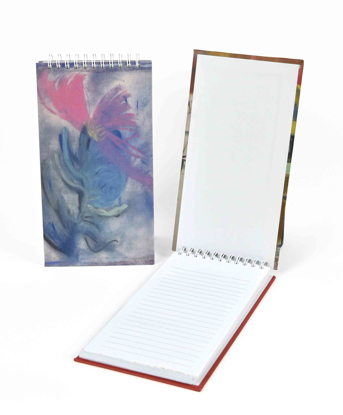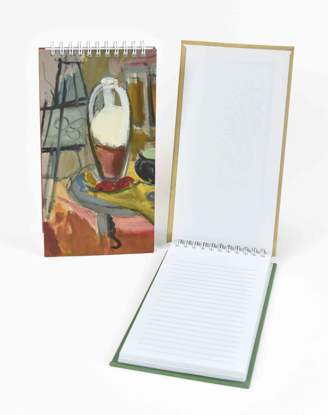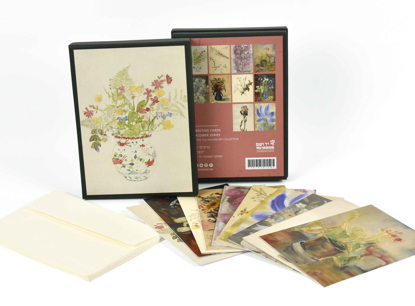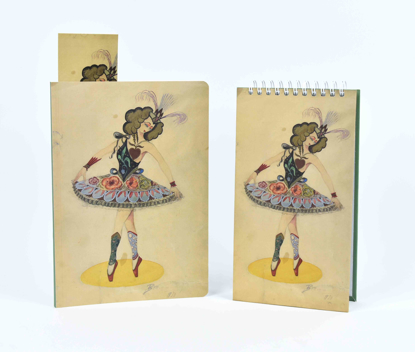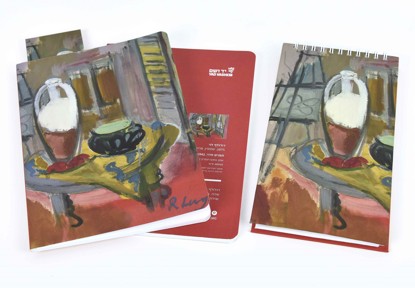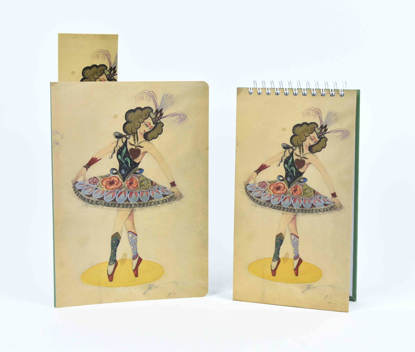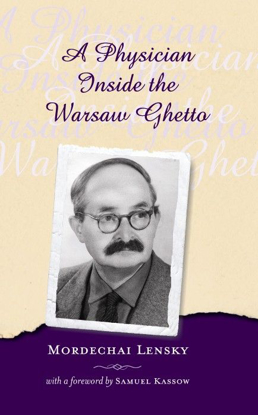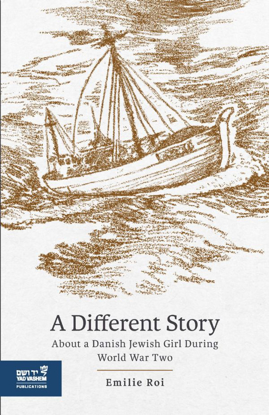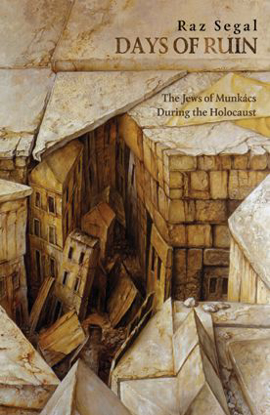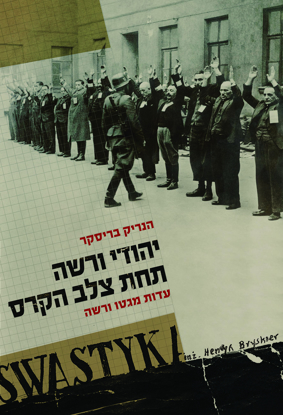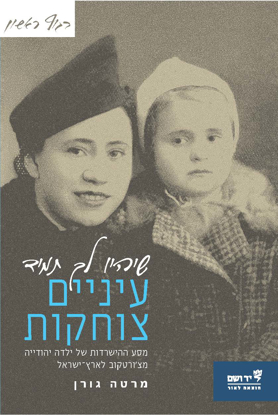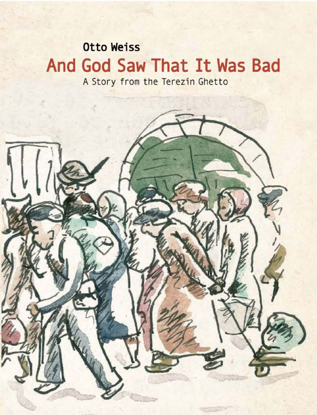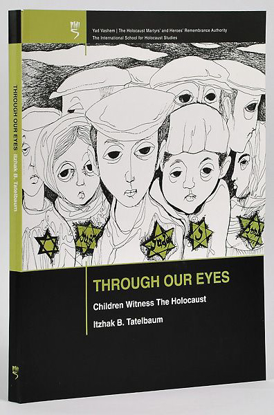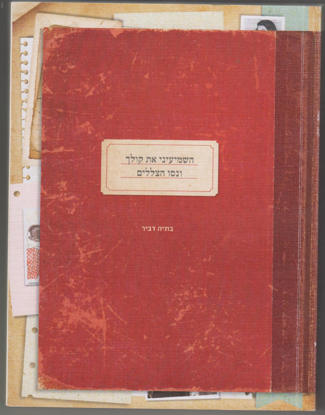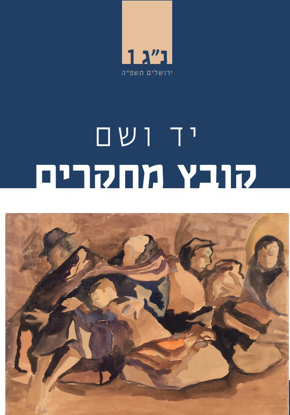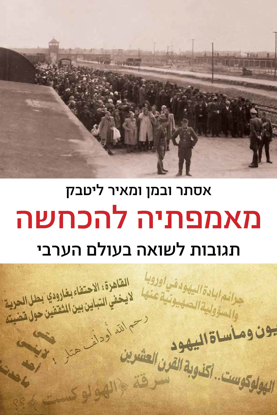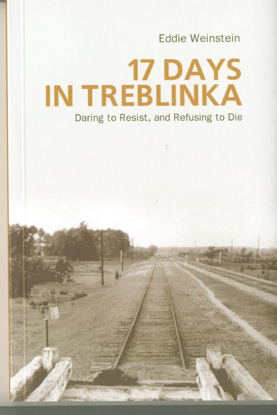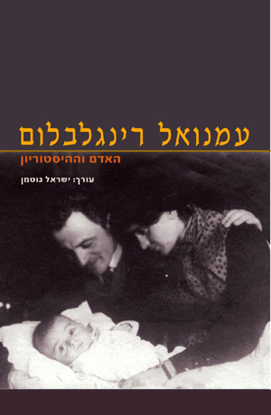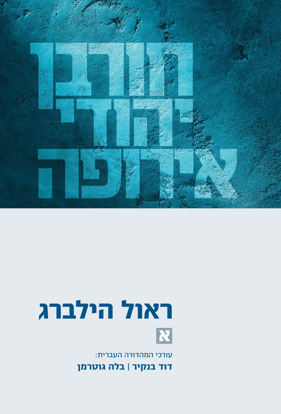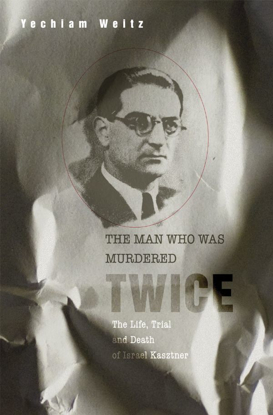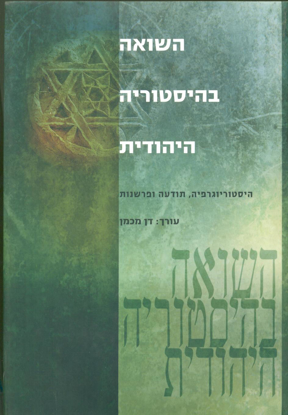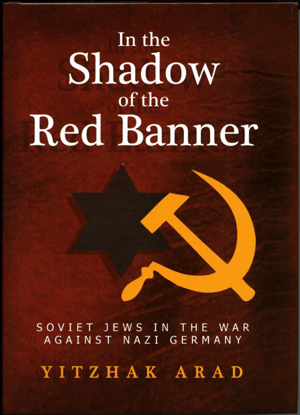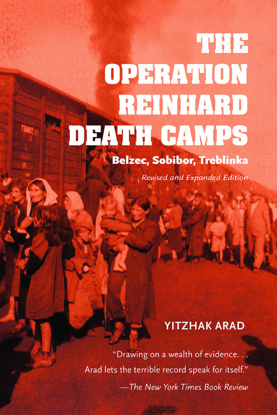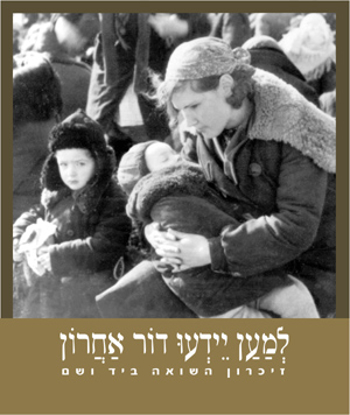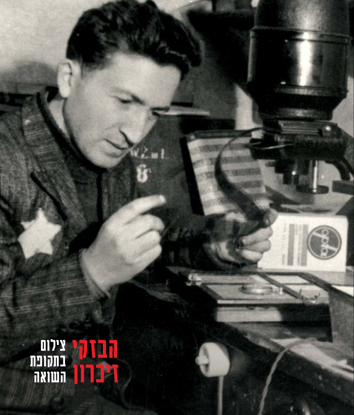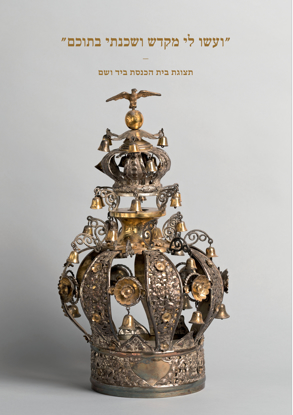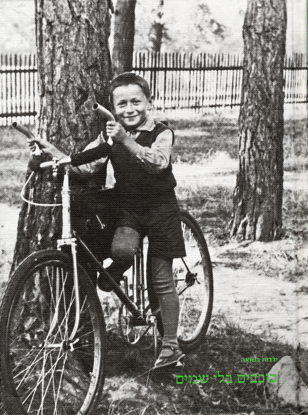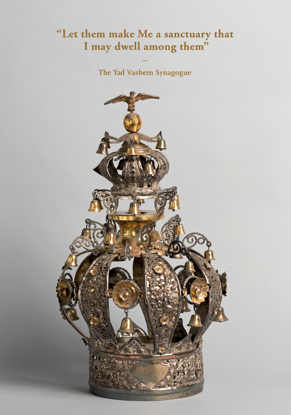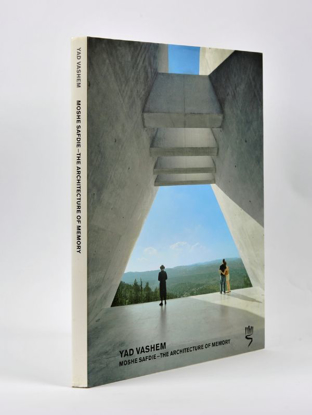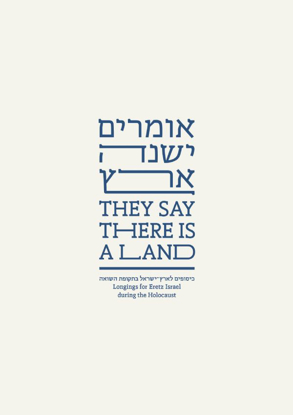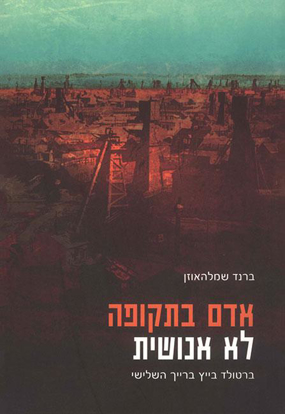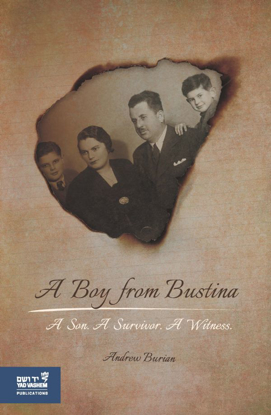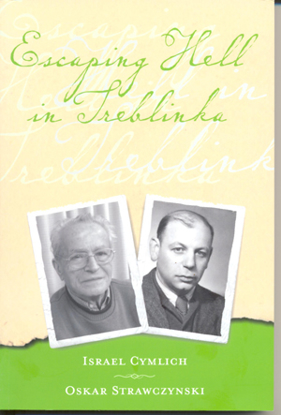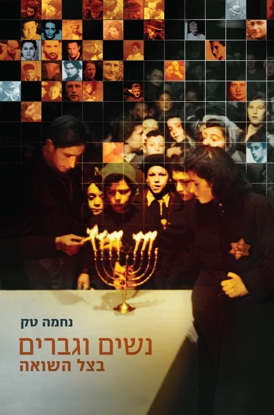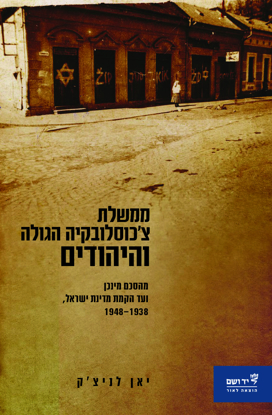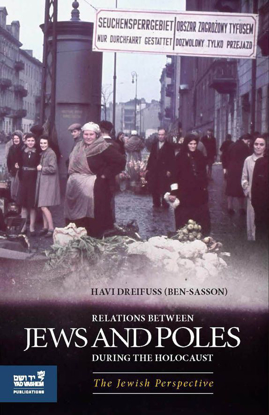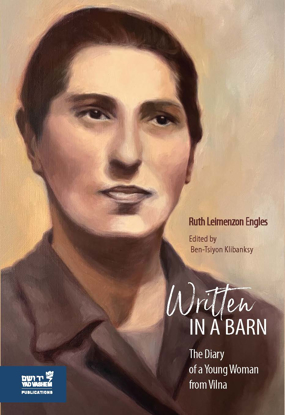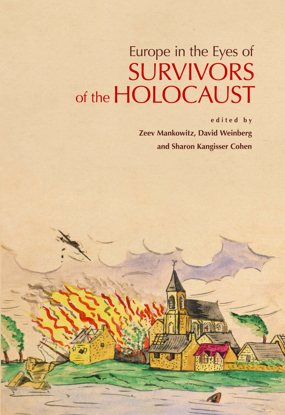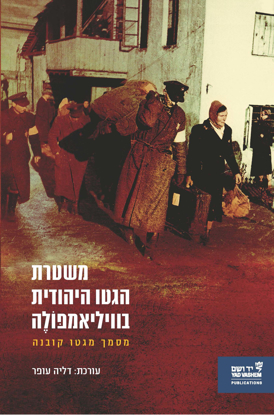- Books in Hebrew
- Yad Vashem Publications
- Other Languages
- Educational Materials
- Gifts & Memorabilia
- Books in Hebrew
- Yad Vashem Publications
- Other Languages
- Educational Materials
- Gifts & Memorabilia
Official Poster - Yom Hashoah 2025
Official Commemorative Poster 2025
"Shaping Memory" Competition
The annual "Shaping Memory" competition, now in its fifteenth year, invites contemporary Israeli artists to portray the Holocaust’s complex and diverse layers of significance through a visual prism. This year’s competition to design the official poster marking Holocaust Martyrs’ and Heroes’ Remembrance Day focused on the theme Out of the Depths: The Anguish of Liberation and Rebirth - Marking 80 Years since the Defeat of Nazi Germany. The winning poster, designed by graphic artist Avraham Yadan, was chosen by a distinguished panel of artists and Holocaust education experts, and is being distributed and displayed across Israel to mark Holocaust Martyrs' and Heroes Remembrance Day 2025.
והשחרור לא בא: יומן ממחנות עבודה ומצעדת מוות
יוסף (יוסק) גיסר
בעריכת עידית גיל
"מרוב תאבון אוכל בערב את הלחם בלי להשאיר שום דבר לבוקר. כך יהיה גרוע יותר. לכן אני מסלק את המחשבות על שובע. אנ ימשתדל לחשוב על אחרי המלחמה ועל ספרים, זה הדבר שאני חולם עליו מילדות, כדי להתפרסם איכשהו. אני מתבייש במחשבה זו, אבל היא אוחזת בי חזק, שפעם אוכל למסור דיווח עיתונאי על התקופה שבה אני חי או אומר בצורה נועזת יותר: להיות סופר. כתבתי זאת אבל אני חושש מאוד מהווידוי שלי". (מתוך יומנו של יוסק גיסר, יום שלישי, 5 בדצמבר 1944)
יוסף (יוסק) גיסר, צעיר יהודי, בן למשפחת חייטים ענייה מרדום שבפולין, כתב יומן בשפה הפולנית בעת שהיה אסיר במחנות עבודה ואולץ להשתתף בצעדות המוות ממחנה אחד למשנהו לקראת סוף המלחמה. ביומן מתועדים חייהם הקשים מנשוא של אסירי המחנות: עבודת הכפייה המפרכת, המחסור בתזונה בסיסית, תנאי התברואה האיומים, המחלות, הטלטלות הרגשיות והמעברים בין המחנות. היומן מעלה תרומה חשובה גם להבנת היחסים בין האסירים היהודים ומעיד על מאמצי ההישרדות הפעילים שלהם.
יוסק גיסר נספה בצעדת המוות שעות לפני השחרור. הוא היה נותר באלמוניותו אילולא הפקיד חברו ששרד, אברהם פישמן, את היומן בבית לוחמי הגטאות ובכך הציל לפחות את המילים, את ביטויי הייאוש והתקווה ואת רצונו העז של יוסק לשרוד ולהיות לעיתונאי וסופר אחרי המלחמה. ככל הידוע, יומנו של יוסק הוא היומן היחיד אשר נכתב בצעדת מוות שהתגלה עד כה, והוא מוגש בתרגום מוער לעברית. מדפי היומן בוקע ועולה קולו של צעיר יהודי חפץ חיים, אחד מרבים כל כך שנספו בשואה.
The Cold Shower of a New Life: The Postwar Diaries of a Child Survivor, Volume 6 - February 2, 1947 – July 12, 1947
Author :Yehuda Bacon
World-renowned Israeli artist and Holocaust survivor Yehuda Bacon began keeping adiary in July 1945, while living in a youth home in Štiřín, Czechoslovakia, shortly after his liberation. During the past seven decades, Bacon has filled over 240 notebooks. His diary is a mosaic of words and drawings through which he remembers his past, contemplates his present, and imagines his future Bacon was born in Moravská Ostrava, Czechoslovakia. In 1942, aged thirteen, he was deported with his family to Theresienstadt. In 1943 he was sent to Auschwitz-Birkenau, where he was interned in the family camp; a few months later, he was among a group of teens selected to work as forced laborers. Bacon survived death marches to Mauthausen and Gunskirchen before he was finally liberated, only to discover that his family had been murdered, aside from one sister who had left Czechoslovakia before the war. Upon his return to Czechoslovakia, Bacon lived in a provisionary youth home run by the humanist Přemysl Pitter. In 1946, Bacon immigrated to Eretz Israel and studied at the Bezalel Academy of . Arts and Design, later becoming a professor of graphics and drawing and achieving fame as an artist
בצל הפרוטקטורט – רדיפת יהודיה בוהמיה ומורוויה, 1939-1945
וולף גרונר
במרס 1939, ערב סיפוחן של בוהמיה ומורוויה לרייך, חיו בתחומן קרוב ל-120,000 יהודים, ולפי ההערכות כ-80,000 מהם נרצחו בשנות מלחמת העולם השנייה.
בספרו בצל הפרוטקטורט וולף גרונר טוען כי בעבר התעלמו ההיסטוריונים מהאפשרות של התפתחויות אוטונומיותברדיפת היהודים בחבל הכבוש שלא בהכוונה מרכזית מברלין: הם סברו שבכל חבל ארץ שסיפחה גרמניה הנאצית לתחומה לפני המלחמה, היא פשוט החילה את המדיניות האנטי-יהודית שהייתה בתוקף בעת סיפוחו.
ואולם, לדברי המחבר, המדיניות כלפי היהודים בפרוטקטורט והקצנתה נקבעו למעשה לפי ארבעה גורמי מפתח: המדיניות המרכזית של ממשלת הרייך בברלין; פעולות מטעם רשויות הפרוטקטורט הגרמניות; הצעדים שנקטה ממשלת הפרוטקטורט בפראג; וההגבלות שהטילו שלל רשויות שלטון מקומיות ואזוריות.
בהסתכמו על הדוחות התקופתיים שהגישה הקהילה היהודית בפראג ללשכה המרכזית להגירת יהודים ועל מגוון מקורות אחרים גרונר מתעד בפרוטרוט את השפעת הרדיפות על היהודים נתיני הפרוטקטורט, על התרוששותם ועל התמעטות סיכוייהם להגר ומבליט את חשיבותן של היוזמות האזוריות והמקומיות בהתפתחותם של הצעדים האנטי-יהודיים ובהקצנתם. לדבריו, יוזמות אחדות שיצאו מהפרוטקטורט השפיעו על קבלת ההחלטות ברייך הגרמני עצמו, ויוזמות אחרות השפיעו על צעדי שננקטו בחבלי ארץ כבושים אחרים.
המחקר מראה גם כיצד הקהילות היהודיות בפרוטקטורט ובעלי התפקידים בהן, שכל צעד וצעד שעשו נבחן בקפידה בידי הגרמנים, פעלו להקלת פגיעתן הרעה של הרדיפות על ידי הרחבתם של שירותי הרווחה, סיוע בהגירה ועזרה בהשמה לעבודה, בין השאר בניצול האינטרסים הסותרים של רשויות שונות. כן עוסק המחקר בצעדים שלא זכו לתשומת לב מספיקת במחקר כגון גטואיזציה מוקדמת בערי השדה ועבודות כפייה, וכאמור לראשונה מוצגת בהלטה פעילותם של מוסדות לא-גרמניים.
חובה מנחמת - תנועת המוסר והשואה בהגות ובמעשה
שלמה טיקוצ'ינסקי
מה למדנו מהמחנות? מה פעל הקב"ה בזה? להשאר אותו הדבר ולא להשתנות? אין זה רק כדי ללמדנו! להיות עובד ה' אמיתי, לצפצף על כל העולם! הגרמנים, עם התרבות, העם הנאור, האומה החכמה, מאלו דווקא יצאו הרוצחים הכי גדולים, מיתות משונות ואכזריות! השכל פשט את הרגל! אין שכל, חייבים ללכת בתמימות על דרך רצון ה'! ר' ישראל דוד נֹויוֹוֶנ ֶ ר, ישיבת נֹוַברדוק.
תנועת המוסר של יהדות ליטא מיסודו של ר' ישראל סלנטר הייתה שיטת חינוך עצמי קפדני ברוח התורה למען הגברת יראת שמים ותקיון המידות. ספר זה בוחן את גורלה והלכי רוחה של התנועה לזרמיה בתקופת השואה ובעקבותיה. בזמן השואה דבקו אנשי המוסר במשנתם החינוכית בדבר חובת האדם והתכנסו בטירטוריה רוחנת משלהם ובה בעת גילו נכונות ויכולת לעמוד בשינויים, הישירו פניהם אל הבאות ואזרו תעצומות נפש. לפתיסתם, האקטואליה אינה אלא שלוחתו של הבורא, היושב עתה על כיסא הדין. לכן נדרש איש המוסר (המוסרניק) בגטו ובמחנות להתכונן נפשית ורוחנית כמו שהוא מתכונן לימי הדין השנתיים; זהו מצב נפשי ורוחני המוכר לו היטב.
בספר חובה מנחמת נסקרת תנועת המוסר על שלושת זרמיה העיקריים: קלם, סלבודקה ונוברדוק. אנשי אשכולת קלם חוו טלטלה עזה בתקופת השואה. בתחילה הם ראו בנאציזם כלי שממנו אפשר להפיק לקח בדבר תכונות מין האדם, אלא שעד מהרה נדמה גישה אוניברסלית זו, ומשנתה של קלם אבדה רובה ככולה בשואה. באשר לסלבודקה, עד השואה התהדרה אסכולה זו גם בפן האוניברסלי של גדלות האדם. באה השואה וערערה את מרכז הכובד שלה. למרות זאת נמצאו לה ממשיכים מובהקים, ואלה לאחר השואה התמקדו באתגרים החדשים שזימנה להם המציאות החברתית והחינוכית בארץ ישראל ובארצות הברית. לעומת שתיהן, אנשי אסכולת נוברדוק התבצרו בעולמם הרוחני הפנימי מפני הגעש שבחוץ, שכן החובות לתיקון הנפש לא השתנו. גם עאשר השואה כילתה כמעט את כל אנשיהם, השורדים והניצולים מצאו בה רק הוכחה לתפיסת עולמם הדיכוטומית המציבה את "התורה" מול "העולם": העולם הוכיח שהוא שרוי בחושף שהמיטו עליו אידיאלים שאינם אלא רוע, פוליטיקה ותככים, שנאה ותחרות.
הספר עומד ברגישות על דקויותיהן של התגובות השונות בתוך תנועת המוסר לנוכח הרעה ומעלה תרומה חשובה ומרתקת לחקר השואה.
Official Poster - Yom Hashoah 2025
Official Commemorative Poster 2025
"Shaping Memory" Competition
The annual "Shaping Memory" competition, now in its fifteenth year, invites contemporary Israeli artists to portray the Holocaust’s complex and diverse layers of significance through a visual prism. This year’s competition to design the official poster marking Holocaust Martyrs’ and Heroes’ Remembrance Day focused on the theme Out of the Depths: The Anguish of Liberation and Rebirth - Marking 80 Years since the Defeat of Nazi Germany. The winning poster, designed by graphic artist Avraham Yadan, was chosen by a distinguished panel of artists and Holocaust education experts, and is being distributed and displayed across Israel to mark Holocaust Martyrs' and Heroes Remembrance Day 2025.
והשחרור לא בא: יומן ממחנות עבודה ומצעדת מוות
יוסף (יוסק) גיסר
בעריכת עידית גיל
"מרוב תאבון אוכל בערב את הלחם בלי להשאיר שום דבר לבוקר. כך יהיה גרוע יותר. לכן אני מסלק את המחשבות על שובע. אנ ימשתדל לחשוב על אחרי המלחמה ועל ספרים, זה הדבר שאני חולם עליו מילדות, כדי להתפרסם איכשהו. אני מתבייש במחשבה זו, אבל היא אוחזת בי חזק, שפעם אוכל למסור דיווח עיתונאי על התקופה שבה אני חי או אומר בצורה נועזת יותר: להיות סופר. כתבתי זאת אבל אני חושש מאוד מהווידוי שלי". (מתוך יומנו של יוסק גיסר, יום שלישי, 5 בדצמבר 1944)
יוסף (יוסק) גיסר, צעיר יהודי, בן למשפחת חייטים ענייה מרדום שבפולין, כתב יומן בשפה הפולנית בעת שהיה אסיר במחנות עבודה ואולץ להשתתף בצעדות המוות ממחנה אחד למשנהו לקראת סוף המלחמה. ביומן מתועדים חייהם הקשים מנשוא של אסירי המחנות: עבודת הכפייה המפרכת, המחסור בתזונה בסיסית, תנאי התברואה האיומים, המחלות, הטלטלות הרגשיות והמעברים בין המחנות. היומן מעלה תרומה חשובה גם להבנת היחסים בין האסירים היהודים ומעיד על מאמצי ההישרדות הפעילים שלהם.
יוסק גיסר נספה בצעדת המוות שעות לפני השחרור. הוא היה נותר באלמוניותו אילולא הפקיד חברו ששרד, אברהם פישמן, את היומן בבית לוחמי הגטאות ובכך הציל לפחות את המילים, את ביטויי הייאוש והתקווה ואת רצונו העז של יוסק לשרוד ולהיות לעיתונאי וסופר אחרי המלחמה. ככל הידוע, יומנו של יוסק הוא היומן היחיד אשר נכתב בצעדת מוות שהתגלה עד כה, והוא מוגש בתרגום מוער לעברית. מדפי היומן בוקע ועולה קולו של צעיר יהודי חפץ חיים, אחד מרבים כל כך שנספו בשואה.
The Cold Shower of a New Life: The Postwar Diaries of a Child Survivor, Volume 6 - February 2, 1947 – July 12, 1947
Author :Yehuda Bacon
World-renowned Israeli artist and Holocaust survivor Yehuda Bacon began keeping adiary in July 1945, while living in a youth home in Štiřín, Czechoslovakia, shortly after his liberation. During the past seven decades, Bacon has filled over 240 notebooks. His diary is a mosaic of words and drawings through which he remembers his past, contemplates his present, and imagines his future Bacon was born in Moravská Ostrava, Czechoslovakia. In 1942, aged thirteen, he was deported with his family to Theresienstadt. In 1943 he was sent to Auschwitz-Birkenau, where he was interned in the family camp; a few months later, he was among a group of teens selected to work as forced laborers. Bacon survived death marches to Mauthausen and Gunskirchen before he was finally liberated, only to discover that his family had been murdered, aside from one sister who had left Czechoslovakia before the war. Upon his return to Czechoslovakia, Bacon lived in a provisionary youth home run by the humanist Přemysl Pitter. In 1946, Bacon immigrated to Eretz Israel and studied at the Bezalel Academy of . Arts and Design, later becoming a professor of graphics and drawing and achieving fame as an artist
בצל הפרוטקטורט – רדיפת יהודיה בוהמיה ומורוויה, 1939-1945
וולף גרונר
במרס 1939, ערב סיפוחן של בוהמיה ומורוויה לרייך, חיו בתחומן קרוב ל-120,000 יהודים, ולפי ההערכות כ-80,000 מהם נרצחו בשנות מלחמת העולם השנייה.
בספרו בצל הפרוטקטורט וולף גרונר טוען כי בעבר התעלמו ההיסטוריונים מהאפשרות של התפתחויות אוטונומיותברדיפת היהודים בחבל הכבוש שלא בהכוונה מרכזית מברלין: הם סברו שבכל חבל ארץ שסיפחה גרמניה הנאצית לתחומה לפני המלחמה, היא פשוט החילה את המדיניות האנטי-יהודית שהייתה בתוקף בעת סיפוחו.
ואולם, לדברי המחבר, המדיניות כלפי היהודים בפרוטקטורט והקצנתה נקבעו למעשה לפי ארבעה גורמי מפתח: המדיניות המרכזית של ממשלת הרייך בברלין; פעולות מטעם רשויות הפרוטקטורט הגרמניות; הצעדים שנקטה ממשלת הפרוטקטורט בפראג; וההגבלות שהטילו שלל רשויות שלטון מקומיות ואזוריות.
בהסתכמו על הדוחות התקופתיים שהגישה הקהילה היהודית בפראג ללשכה המרכזית להגירת יהודים ועל מגוון מקורות אחרים גרונר מתעד בפרוטרוט את השפעת הרדיפות על היהודים נתיני הפרוטקטורט, על התרוששותם ועל התמעטות סיכוייהם להגר ומבליט את חשיבותן של היוזמות האזוריות והמקומיות בהתפתחותם של הצעדים האנטי-יהודיים ובהקצנתם. לדבריו, יוזמות אחדות שיצאו מהפרוטקטורט השפיעו על קבלת ההחלטות ברייך הגרמני עצמו, ויוזמות אחרות השפיעו על צעדי שננקטו בחבלי ארץ כבושים אחרים.
המחקר מראה גם כיצד הקהילות היהודיות בפרוטקטורט ובעלי התפקידים בהן, שכל צעד וצעד שעשו נבחן בקפידה בידי הגרמנים, פעלו להקלת פגיעתן הרעה של הרדיפות על ידי הרחבתם של שירותי הרווחה, סיוע בהגירה ועזרה בהשמה לעבודה, בין השאר בניצול האינטרסים הסותרים של רשויות שונות. כן עוסק המחקר בצעדים שלא זכו לתשומת לב מספיקת במחקר כגון גטואיזציה מוקדמת בערי השדה ועבודות כפייה, וכאמור לראשונה מוצגת בהלטה פעילותם של מוסדות לא-גרמניים.
חובה מנחמת - תנועת המוסר והשואה בהגות ובמעשה
שלמה טיקוצ'ינסקי
מה למדנו מהמחנות? מה פעל הקב"ה בזה? להשאר אותו הדבר ולא להשתנות? אין זה רק כדי ללמדנו! להיות עובד ה' אמיתי, לצפצף על כל העולם! הגרמנים, עם התרבות, העם הנאור, האומה החכמה, מאלו דווקא יצאו הרוצחים הכי גדולים, מיתות משונות ואכזריות! השכל פשט את הרגל! אין שכל, חייבים ללכת בתמימות על דרך רצון ה'! ר' ישראל דוד נֹויוֹוֶנ ֶ ר, ישיבת נֹוַברדוק.
תנועת המוסר של יהדות ליטא מיסודו של ר' ישראל סלנטר הייתה שיטת חינוך עצמי קפדני ברוח התורה למען הגברת יראת שמים ותקיון המידות. ספר זה בוחן את גורלה והלכי רוחה של התנועה לזרמיה בתקופת השואה ובעקבותיה. בזמן השואה דבקו אנשי המוסר במשנתם החינוכית בדבר חובת האדם והתכנסו בטירטוריה רוחנת משלהם ובה בעת גילו נכונות ויכולת לעמוד בשינויים, הישירו פניהם אל הבאות ואזרו תעצומות נפש. לפתיסתם, האקטואליה אינה אלא שלוחתו של הבורא, היושב עתה על כיסא הדין. לכן נדרש איש המוסר (המוסרניק) בגטו ובמחנות להתכונן נפשית ורוחנית כמו שהוא מתכונן לימי הדין השנתיים; זהו מצב נפשי ורוחני המוכר לו היטב.
בספר חובה מנחמת נסקרת תנועת המוסר על שלושת זרמיה העיקריים: קלם, סלבודקה ונוברדוק. אנשי אשכולת קלם חוו טלטלה עזה בתקופת השואה. בתחילה הם ראו בנאציזם כלי שממנו אפשר להפיק לקח בדבר תכונות מין האדם, אלא שעד מהרה נדמה גישה אוניברסלית זו, ומשנתה של קלם אבדה רובה ככולה בשואה. באשר לסלבודקה, עד השואה התהדרה אסכולה זו גם בפן האוניברסלי של גדלות האדם. באה השואה וערערה את מרכז הכובד שלה. למרות זאת נמצאו לה ממשיכים מובהקים, ואלה לאחר השואה התמקדו באתגרים החדשים שזימנה להם המציאות החברתית והחינוכית בארץ ישראל ובארצות הברית. לעומת שתיהן, אנשי אסכולת נוברדוק התבצרו בעולמם הרוחני הפנימי מפני הגעש שבחוץ, שכן החובות לתיקון הנפש לא השתנו. גם עאשר השואה כילתה כמעט את כל אנשיהם, השורדים והניצולים מצאו בה רק הוכחה לתפיסת עולמם הדיכוטומית המציבה את "התורה" מול "העולם": העולם הוכיח שהוא שרוי בחושף שהמיטו עליו אידיאלים שאינם אלא רוע, פוליטיקה ותככים, שנאה ותחרות.
הספר עומד ברגישות על דקויותיהן של התגובות השונות בתוך תנועת המוסר לנוכח הרעה ומעלה תרומה חשובה ומרתקת לחקר השואה.
Set of 2 Notebooks + Bookmark "Flower" - English
Set of 1 Notebook + 1 Spiral Notepad + 1 Bookmark
// ENGLISH //
Theme:
"Pink Flower in a Blue-Black Frame", 1942
Hanna Helmann (1877, Nürnberg -1942, Sobibor)
Oil crayon on tracing paper
From the Yad Vashem Art Collection
Having earned a doctorate in philosophy, Hanna Hellmann worked as a lecturer in the School of Social Work in Frankfurt. In May 1938, she was hospitalized in a sanatorium. On 15 June 1942, she was deported together with the patients and staff to Sobibor, where she was murdered.
Make a meaningful gift - Help perpetuate the Memory of the Holocaust
Set of 2 Notebooks + Bookmark "Interior" - English
Set of 1 Notebook + 1 Spiral Notepad + 1 Bookmark
// ENGLISH //
Theme:
"INTERIOR", 1942
Rudolf Levy (1875, Stettin, Prussia -1944, Auschwitz-Birkenau)
Oil, gouache and pencil on paper
From the Yad Vashem Art Collection
Rudolf Levy studied at the Fine Arts Academy in Munich. When the war broke out in 1939, he was living in Florence and tried – unsuccessfully - to leave for the USA. He was arrested in December 1943. On 5 April 1944, he was deported on Convoy No. 9 to Auschwitz where he was murdered.
Make a meaningful gift - Help perpetuate the Memory of the Holocaust
Box of 10 Greeting Cards "The Flower Series"
GREETING CARDS "THE FLOWER SERIES"
From the Yad Vashem Art Collection
A hand-picked selection of 10 Greeting cards + 10 envelopes
Many of the works hosted by Yad Vashem depict the reality of life during the Holocaust. But along with the urge to document daily life, artists searched for a way to break free from their cruel environment, and also provided their fellow inmates with an opportunity to forget, even just for a moment, the hardships of the ghettos and camps.
Make a meaningful gift - Help perpetuate the Memory of the Holocaust
Set of 2 Notebooks + Bookmark "Dancer" - Hebrew
Set of 1 Notebook + 1 Spiral Notepad + 1 Bookmark
// LABELS IN HEBREW //
Theme:
"DANCER: Sketch of a Dress", 1930
David Brainin (1905, Kharkov, Ukraine -1942, Auschwitz-Birkenau)
Gouache and pencil on paper
From the Yad Vashem Art Collection
David Brainin studied at Ecole des Beaux-Arts in Paris. Arrested on 29 April 1942, he was interned in Drancy and later in Compiègne. On 18 September 1942, he was deported on Transport No. 34 to Auschwitz, where he was murdered.
Make a meaningful gift - Help perpetuate the Memory of the Holocaust
Set of 2 Notebooks + Bookmark "Interior" - Hebrew
Set of 1 Notebook + 1 Spiral Notepad + 1 Bookmark
// HEBREW //
Theme:
"INTERIOR", 1942
Rudolf Levy (1875, Stettin, Prussia -1944, Auschwitz-Birkenau)
Oil, gouache and pencil on paper
From the Yad Vashem Art Collection
Rudolf Levy studied at the Fine Arts Academy in Munich. When the war broke out in 1939, he was living in Florence and tried – unsuccessfully - to leave for the USA. He was arrested in December 1943. On 5 April 1944, he was deported on Convoy No. 9 to Auschwitz where he was murdered.
Make a meaningful gift - Help perpetuate the Memory of the Holocaust
Set of 2 Notebooks + Bookmark "Dancer" - English
Set of 1 Notebook + 1 Spiral Notepad + 1 Bookmark
// LABELS IN ENGLISH //
Theme:
"DANCER: Sketch of a Dress", 1930
David Brainin (1905, Kharkov, Ukraine -1942, Auschwitz-Birkenau)
Gouache and pencil on paper
From the Yad Vashem Art Collection
David Brainin studied at Ecole des Beaux-Arts in Paris. Arrested on 29 April 1942, he was interned in Drancy and later in Compiègne. On 18 September 1942, he was deported on Transport No. 34 to Auschwitz, where he was murdered.
Make a meaningful gift - Help perpetuate the Memory of the Holocaust
Set of 2 Notebooks + Bookmark "Flower" - English
Set of 1 Notebook + 1 Spiral Notepad + 1 Bookmark
// ENGLISH //
Theme:
"Pink Flower in a Blue-Black Frame", 1942
Hanna Helmann (1877, Nürnberg -1942, Sobibor)
Oil crayon on tracing paper
From the Yad Vashem Art Collection
Having earned a doctorate in philosophy, Hanna Hellmann worked as a lecturer in the School of Social Work in Frankfurt. In May 1938, she was hospitalized in a sanatorium. On 15 June 1942, she was deported together with the patients and staff to Sobibor, where she was murdered.
Make a meaningful gift - Help perpetuate the Memory of the Holocaust
Set of 2 Notebooks + Bookmark "Interior" - English
Set of 1 Notebook + 1 Spiral Notepad + 1 Bookmark
// ENGLISH //
Theme:
"INTERIOR", 1942
Rudolf Levy (1875, Stettin, Prussia -1944, Auschwitz-Birkenau)
Oil, gouache and pencil on paper
From the Yad Vashem Art Collection
Rudolf Levy studied at the Fine Arts Academy in Munich. When the war broke out in 1939, he was living in Florence and tried – unsuccessfully - to leave for the USA. He was arrested in December 1943. On 5 April 1944, he was deported on Convoy No. 9 to Auschwitz where he was murdered.
Make a meaningful gift - Help perpetuate the Memory of the Holocaust
Box of 10 Greeting Cards "The Flower Series"
GREETING CARDS "THE FLOWER SERIES"
From the Yad Vashem Art Collection
A hand-picked selection of 10 Greeting cards + 10 envelopes
Many of the works hosted by Yad Vashem depict the reality of life during the Holocaust. But along with the urge to document daily life, artists searched for a way to break free from their cruel environment, and also provided their fellow inmates with an opportunity to forget, even just for a moment, the hardships of the ghettos and camps.
Make a meaningful gift - Help perpetuate the Memory of the Holocaust
Set of 2 Notebooks + Bookmark "Dancer" - Hebrew
Set of 1 Notebook + 1 Spiral Notepad + 1 Bookmark
// LABELS IN HEBREW //
Theme:
"DANCER: Sketch of a Dress", 1930
David Brainin (1905, Kharkov, Ukraine -1942, Auschwitz-Birkenau)
Gouache and pencil on paper
From the Yad Vashem Art Collection
David Brainin studied at Ecole des Beaux-Arts in Paris. Arrested on 29 April 1942, he was interned in Drancy and later in Compiègne. On 18 September 1942, he was deported on Transport No. 34 to Auschwitz, where he was murdered.
Make a meaningful gift - Help perpetuate the Memory of the Holocaust
Set of 2 Notebooks + Bookmark "Interior" - Hebrew
Set of 1 Notebook + 1 Spiral Notepad + 1 Bookmark
// HEBREW //
Theme:
"INTERIOR", 1942
Rudolf Levy (1875, Stettin, Prussia -1944, Auschwitz-Birkenau)
Oil, gouache and pencil on paper
From the Yad Vashem Art Collection
Rudolf Levy studied at the Fine Arts Academy in Munich. When the war broke out in 1939, he was living in Florence and tried – unsuccessfully - to leave for the USA. He was arrested in December 1943. On 5 April 1944, he was deported on Convoy No. 9 to Auschwitz where he was murdered.
Make a meaningful gift - Help perpetuate the Memory of the Holocaust
Set of 2 Notebooks + Bookmark "Dancer" - English
Set of 1 Notebook + 1 Spiral Notepad + 1 Bookmark
// LABELS IN ENGLISH //
Theme:
"DANCER: Sketch of a Dress", 1930
David Brainin (1905, Kharkov, Ukraine -1942, Auschwitz-Birkenau)
Gouache and pencil on paper
From the Yad Vashem Art Collection
David Brainin studied at Ecole des Beaux-Arts in Paris. Arrested on 29 April 1942, he was interned in Drancy and later in Compiègne. On 18 September 1942, he was deported on Transport No. 34 to Auschwitz, where he was murdered.
Make a meaningful gift - Help perpetuate the Memory of the Holocaust
Set of 2 Notebooks + Bookmark "Flower" - English
Set of 1 Notebook + 1 Spiral Notepad + 1 Bookmark
// ENGLISH //
Theme:
"Pink Flower in a Blue-Black Frame", 1942
Hanna Helmann (1877, Nürnberg -1942, Sobibor)
Oil crayon on tracing paper
From the Yad Vashem Art Collection
Having earned a doctorate in philosophy, Hanna Hellmann worked as a lecturer in the School of Social Work in Frankfurt. In May 1938, she was hospitalized in a sanatorium. On 15 June 1942, she was deported together with the patients and staff to Sobibor, where she was murdered.
Make a meaningful gift - Help perpetuate the Memory of the Holocaust
Set of 2 Notebooks + Bookmark "Interior" - English
Set of 1 Notebook + 1 Spiral Notepad + 1 Bookmark
// ENGLISH //
Theme:
"INTERIOR", 1942
Rudolf Levy (1875, Stettin, Prussia -1944, Auschwitz-Birkenau)
Oil, gouache and pencil on paper
From the Yad Vashem Art Collection
Rudolf Levy studied at the Fine Arts Academy in Munich. When the war broke out in 1939, he was living in Florence and tried – unsuccessfully - to leave for the USA. He was arrested in December 1943. On 5 April 1944, he was deported on Convoy No. 9 to Auschwitz where he was murdered.
Make a meaningful gift - Help perpetuate the Memory of the Holocaust
שיהיו לך תמיד עיניים צוחקות: מסע ההישרדות של ילדה יהודייה מצ'ורטקוב לארץ-ישראל
מרטה גורן
עכשיו את קריסיה. תלכי תמיד זקופה, תסתכלי לאנשים בעיניים, שאיש לא יחשוב שאת מפחדת או מסתירה סוד נורא. האירי את פנייך, אנשים אוהבים ילדים מחייכים. והעיקר – שעינייך יהיו תמיד צוחקות כי רק לילדים יהודים יש עיניים עצובות.
ככה אמרה אמא נטקה למרטה, ילדתה בת השמונה, כשהוציאה אותה ממרתף בית המרקחת שבו עבדה ושלחה אותה מצ'וֹרטקוּב לוורשה בזהות בדויה. מרטה לא ראתה עוד את אמהּ והמילים האחרונות האלה היו לה לציווי, לצוואה.
השמיעיני את קולך ונסו הצללים: מבחר מקורות מאת נשים בתקופת השואה
עורכת: בתיה דביר
בשיתוף הוצאת מורשת
שיהיו לך תמיד עיניים צוחקות: מסע ההישרדות של ילדה יהודייה מצ'ורטקוב לארץ-ישראל
מרטה גורן
עכשיו את קריסיה. תלכי תמיד זקופה, תסתכלי לאנשים בעיניים, שאיש לא יחשוב שאת מפחדת או מסתירה סוד נורא. האירי את פנייך, אנשים אוהבים ילדים מחייכים. והעיקר – שעינייך יהיו תמיד צוחקות כי רק לילדים יהודים יש עיניים עצובות.
ככה אמרה אמא נטקה למרטה, ילדתה בת השמונה, כשהוציאה אותה ממרתף בית המרקחת שבו עבדה ושלחה אותה מצ'וֹרטקוּב לוורשה בזהות בדויה. מרטה לא ראתה עוד את אמהּ והמילים האחרונות האלה היו לה לציווי, לצוואה.
השמיעיני את קולך ונסו הצללים: מבחר מקורות מאת נשים בתקופת השואה
עורכת: בתיה דביר
בשיתוף הוצאת מורשת
מאמפתיה להכחשה: תגובות לשואה בעולם הערבי
אסתר ובמן, מאיר ליטבק | מאנגלית: יהודה פורת
בשיתוף הוצאת מאגנס
חורבן יהודי אירופה
ראול הילברג
עורכי המהדורה העברית דוד בנקיר, בלה גוטרמן | מאנגלית: איה ברויר
The Jewish Voice in the Ghettos and Concentration Camps: Verbal Expression under Nazi Oppression
Yisrael Kaplan | Editor: Zeev W. Mankowitz
המטפיזיקה של הגזע: מדע ואמונה בהשקפת העולם הנאצית
עמית ורשיצקי
מהו הנאציזם ומה פשר כוחו הרעיוני? מה היו מקורות ההשראה הפילוסופיים של השקפת העולם הנאצית ובאיזו מידה היא נשענה על יסודות מדעיים? באילו מובנים המסגרת הרעיונית והמושגית שהציע הנאציזם הציגה עולם ערכי ונורמטיבי חדש שסיפק מענה לרחשי לב של גרמנים רבים בעולם מודרני ומחולן? ספר זה מבקש לענות על שאלות סבוכות אלה באמצעות ניתוח כתביהם של הוגים, מדעני גזע ותיאורטיקנים פוליטיים בגרמניה בין שתי מלחמות העולם.
מאמפתיה להכחשה: תגובות לשואה בעולם הערבי
אסתר ובמן, מאיר ליטבק | מאנגלית: יהודה פורת
בשיתוף הוצאת מאגנס
חורבן יהודי אירופה
ראול הילברג
עורכי המהדורה העברית דוד בנקיר, בלה גוטרמן | מאנגלית: איה ברויר
The Jewish Voice in the Ghettos and Concentration Camps: Verbal Expression under Nazi Oppression
Yisrael Kaplan | Editor: Zeev W. Mankowitz
המטפיזיקה של הגזע: מדע ואמונה בהשקפת העולם הנאצית
עמית ורשיצקי
מהו הנאציזם ומה פשר כוחו הרעיוני? מה היו מקורות ההשראה הפילוסופיים של השקפת העולם הנאצית ובאיזו מידה היא נשענה על יסודות מדעיים? באילו מובנים המסגרת הרעיונית והמושגית שהציע הנאציזם הציגה עולם ערכי ונורמטיבי חדש שסיפק מענה לרחשי לב של גרמנים רבים בעולם מודרני ומחולן? ספר זה מבקש לענות על שאלות סבוכות אלה באמצעות ניתוח כתביהם של הוגים, מדעני גזע ותיאורטיקנים פוליטיים בגרמניה בין שתי מלחמות העולם.
למען יידעו דור אחרון: זיכרון השואה ביד ושם - אלבום המוזיאון החדש
עורכים: בלה גוטרמן, אבנר שלו
"ועשו לי מקדש ושכנתי בתוכם": תצוגת בית הכנסת ביד ושם
אוצרת: חביבה פלד-כרמלי, אוצרי משנה: מיכאל טל, שרה שור
קטלוג בית הכנסת - החפצים המוצגים בבית הכנסת ביד ושם הם חלק מאלפי חפצים המצויים באוספי יד ושם ומספרים את סיפורו של העם היהודי. סיפורים אלה מהווים פסיפס רחב של זיכרונות הקשורים לגורלם של יחידים, משפחות וקהילות בתקופת השואה. פריטי האוסף מייצגים סיפורים שבהם שזורים רגעי חרדה, ייאוש ואובדן, אך גם רגעים של תושייה, חמלה, תקווה, אומץ לב ואהבה. זיכרונות אלה מעוררים הזדהות עם גורלם של הקורבנות ומציבים במרכז הנרטיב של המוזיאון לתולדות השואה את האדם היהודי בשואה. חשיבותם של החפצים שמספרים סיפור מועצמת באמצעות השזירה שלהם כחלק ממארג המעצב זיכרון קולקטיבי מתוך שלל שברי זיכרונות אישיים. חלל בית הכנסת ביד ושם והתצוגה שמוצבת בו כרוכים זה בזה ומספרים את הסיפור של רקמת החיים היהודיים שאבדה בשואה. חורבן העבר מוצג אל מול המשכיותם של החיים היהודיים בהווה. סיפורים אלה מהווים עדות אילמת להיסטוריה של יחידים וקהילות בתקופת השואה שאנו מבקשים להנציח ולהנחיל לדורות הבאים.
To Bear Witness: Holocaust Remembrance at Yad Vashem
Editors: Bella Gutterman and Avner Shalev
"Let them make Me a sanctuary that I may dwell among them”: The Yad Vashem Synagogue
Curator: Haviva Peled-Carmeli, Deputy Curators: Michael Tal, Sara Shor
The Yad Vashem Synagogue catalogue - The artifacts displayed in the Yad Vashem Synagogue are a few of the thousands of items preserved in Yad Vashem's collections that tell the story of the Jewish people – a panoramic mosaic of memories depicting the fate of individuals, families and communities during the Holocaust. The artifacts in our collections tell stories interwoven with flashes of fear, despair and loss, but also moments of determination, pity, hope, courage and love. These stories evoke empathy with the fate of the victims, and place the Jewish individual at the heart of the narrative that unfolds in the Holocaust History Museum. The significance of these artifacts is hoin ned by their integration the vast, complex fabric that shapes collective memory from countless fragments of personal recollection. The display area and the space currently used as the Synagogue combine to depict the lost Jewish life in the face of its continuity today. These artifacts bear mute testimony to the history and legacy of individuals and communities during the Holocaust that we seek to commemorate and to impart to future generations.
Yad Vashem: Moshe Safdie - The Architecture of Memory
Articles by Joan Ockman, Moshe Safdie, Avner Shalev, Elie Wiesel
They Say there is a Land: Longing for Eretz Israel during the Holocaust
Head Curator: Vivian Uria
Art from the Holocaust: 100 Artworks from the Yad Vashem Collection
Editors: Eliad Moreh-Rosenberg, Walter Smerling
למען יידעו דור אחרון: זיכרון השואה ביד ושם - אלבום המוזיאון החדש
עורכים: בלה גוטרמן, אבנר שלו
"ועשו לי מקדש ושכנתי בתוכם": תצוגת בית הכנסת ביד ושם
אוצרת: חביבה פלד-כרמלי, אוצרי משנה: מיכאל טל, שרה שור
קטלוג בית הכנסת - החפצים המוצגים בבית הכנסת ביד ושם הם חלק מאלפי חפצים המצויים באוספי יד ושם ומספרים את סיפורו של העם היהודי. סיפורים אלה מהווים פסיפס רחב של זיכרונות הקשורים לגורלם של יחידים, משפחות וקהילות בתקופת השואה. פריטי האוסף מייצגים סיפורים שבהם שזורים רגעי חרדה, ייאוש ואובדן, אך גם רגעים של תושייה, חמלה, תקווה, אומץ לב ואהבה. זיכרונות אלה מעוררים הזדהות עם גורלם של הקורבנות ומציבים במרכז הנרטיב של המוזיאון לתולדות השואה את האדם היהודי בשואה. חשיבותם של החפצים שמספרים סיפור מועצמת באמצעות השזירה שלהם כחלק ממארג המעצב זיכרון קולקטיבי מתוך שלל שברי זיכרונות אישיים. חלל בית הכנסת ביד ושם והתצוגה שמוצבת בו כרוכים זה בזה ומספרים את הסיפור של רקמת החיים היהודיים שאבדה בשואה. חורבן העבר מוצג אל מול המשכיותם של החיים היהודיים בהווה. סיפורים אלה מהווים עדות אילמת להיסטוריה של יחידים וקהילות בתקופת השואה שאנו מבקשים להנציח ולהנחיל לדורות הבאים.
To Bear Witness: Holocaust Remembrance at Yad Vashem
Editors: Bella Gutterman and Avner Shalev
"Let them make Me a sanctuary that I may dwell among them”: The Yad Vashem Synagogue
Curator: Haviva Peled-Carmeli, Deputy Curators: Michael Tal, Sara Shor
The Yad Vashem Synagogue catalogue - The artifacts displayed in the Yad Vashem Synagogue are a few of the thousands of items preserved in Yad Vashem's collections that tell the story of the Jewish people – a panoramic mosaic of memories depicting the fate of individuals, families and communities during the Holocaust. The artifacts in our collections tell stories interwoven with flashes of fear, despair and loss, but also moments of determination, pity, hope, courage and love. These stories evoke empathy with the fate of the victims, and place the Jewish individual at the heart of the narrative that unfolds in the Holocaust History Museum. The significance of these artifacts is hoin ned by their integration the vast, complex fabric that shapes collective memory from countless fragments of personal recollection. The display area and the space currently used as the Synagogue combine to depict the lost Jewish life in the face of its continuity today. These artifacts bear mute testimony to the history and legacy of individuals and communities during the Holocaust that we seek to commemorate and to impart to future generations.
Yad Vashem: Moshe Safdie - The Architecture of Memory
Articles by Joan Ockman, Moshe Safdie, Avner Shalev, Elie Wiesel
They Say there is a Land: Longing for Eretz Israel during the Holocaust
Head Curator: Vivian Uria
אדם בתקופה לא אנושית: ברטולד בייץ ברייך השלישי
ברנד שמלהאוזן | מגרמנית: דפנה עמית
ביולי 1941 הגיע הגרמני ברטולד בייץ בן ה-27 לעיר בוריסלב כדי לנהל את החברה להפקת נפט במזרח גליציה והיה עֵד להשמדה המתמשכת של יהודים בידי הנאצים. הוא התייצב ללא היסוס נגד תכנית ההשמדה והצליח לשחרר מאות יהודים ואפילו להוציאם מרכבות שהובילו אותם למחנה ההשמדה בלז'ץ. ברטולד בייץ ואשתו אלזה סיפקו בסתר מזון ליהודים וגם הנפיקו להם תעודות עבודה מזויפות. שניהם הוכרו כחסידי אומות העולם.
"רבות נכתב על מי שהיו מעורבים באותן שנים חשוכות של ההיסטוריה הגרמנית במעשים שיש בהם אשמה כבדה, שהעטו בושה שלא תשוער על העם הגרמני. חומר מועט ראה אור על מי שייצגו באותה בעת את 'גרמניה האחרת' וניסו לעכב את הרוצחים. ברטולד בייץ הוא אחד מהם. אסור שהאומץ והאנושיות שלו יישכחו". [ברנד שמלהאוזן, אביב 1991].
A Boy from Buština: A Son. A Survivor. A Witness.
Andrew Burian
A sheltered boy from the small town of Buština (then Czechoslovakia, now Ukraine), Andrew had a beautiful carefree childhood. At the age of thirteen, his world was shattered. Andrew’s wartime odyssey began with deportation from his hometown to Mateszalka ghetto in Hungary. From there, Andrew and his family were deported to Auschwitz-Birkenau, where he survived countless selections and near death experiences. In the freezing winter of 1945, he survived the infamous “death march” evacuation of Auschwitz-Birkenau and was loaded into a cattle car for the long journey to the Mauthausen concentration camp in Austria. Andrew survived another death-march to the Gunskirchen concentration camp from which he was ultimately liberated by the U.S. army. Andrew’s journey took him through Hungary, Poland, Austria, Czechoslovakia, England and, finally, the USA where he made a new life.
הייתי פרטיזן יהודי: לחימה והצלה ביערות לובלין
פרנק בלייכמן
פרנק בלייכמן היה בן 16 כשפרצה המלחמה ב־1939, עם הפלישה הגרמנית לפולין. תחילה שטף את קַמיוֹנקה, עיירת הולדתו, זרם פליטים יהודים מוורשה המופצצת. אחריהם באו חיילים פולנים נסוגים. זמן קצר אחרי שהגיעו חיילים גרמנים לקַמיוֹנקה הם החלו להתעלל ביהודים ובלייכמן הנער ראה, הזדעזע ונשבע לנקום. כעבור שלוש שנים עלה בידו להגשים את שבועתו. ערב הגירוש מגטו קַמיוֹנקה, באוקטובר 1942, החליט פרנק לברוח. הוא פגש בדרכו בורחים צעירים נוספים והקים איתם יחידה פרטיזנית. חלק הארי של ספר הזיכרונות הזה הוא סיפור השנתיים שעשה ביערות. פרנק בלייכמן היה צעיר, נועז, בעל תושייה וחושים חדים וכושר מנהיגות, תכונות שבאו לידי ביטוי בסיפור הישרדותו ביער בתור פרטיזן. סיפורו של בלייכמן הוא סיפורם של הפרטיזנים היהודים ביער פַּרצֶ'ב שבמחוז לובלין – אזור שהתנהלו בו מאבקי כוח עקובים מדם בין תנועות פרטיזניות פולניות למיניהן – על הקשיים הפיזיים והנפשיים שהכבידו עליהם ועל הסכנות שארבו להם הן מצד הגרמנים והן מצד הקבוצות הפרטיזניות הפולניות האנטישמיות והמלשינים המקומיים. אבל בייחוד זהו סיפור על הערבות ההדדית היהודית של הפרטיזנים היהודים שקיבלו עליהם לדאוג ולהציל יהודים שברחו מן האקציות אל היער. הספר הייתי פרטיזן יהודי שופך אור על סוגיה שלא נחקרה דיה של התנועה הפרטיזנית היהודית בתחום הגנרלגוברנמן. "זהו סיפור מרתק על סבל, על עמידה ועל ניצחונה של רוח האדם, משׂוּאה של תקווה לכל התוהים כיצד ייתכן שהטוב ינצח אי־פעם את הרע בעולם טרוף סערות. חשיבות הלקח שהוא מלמד, אומץ ודבקות במטרה, בעינה עומדת. יהודים יכולים לזקוף ראש כשהם קוראים את הדפים הללו; וכל בני האדם, באשר הם, בכל מאבקיהם, יכולים להתמלא גאווה על מה שיכולים בני אנוש לחולל כשהם לוקחים את גורלם בידיהם." [סר מרטין גילברט]
Escaping Hell in Treblinka
Israel Cymlich; Oskar Strawczynski | Foreword by David Silberklang
Escaping Hell in Treblinka includes two remarkable documents written by two survivors of that hellish darkness while the authors were still in hiding, unsure if they would succeed in evading the Nazis. Israel Cymlich’s memoir provides a rare insight into the Treblinka I forced labor camp’s brutal daily life, as well as the regular contact and human traffic between the two Treblinka camps. Srul escaped in April 1943, just before he was due to be transferred to the Treblinka II extermination camp. Oskar Strawczynski’s memoir is one of the earliest written eyewitness accounts of the August 1943 uprising in Treblinka. He tells of Jewish camp officials’ cruel treatment of their fellow Jewish prisoners; the viciousness of the German staff; preparations for the uprising, and life after the mass escape from the camp. Both men owed their survival to their own daring and initiative as well as to the assistance they received from a variety of people, including Polish rescuers.
נשים וגברים בצל השואה
נחמה טק
שואת העם היהודי הייתה מנת חלקם של נשים וגברים כאחד. האם חוו נשים וגברים את השואה בדרכים שונות? מה עלה בגורלם בסביבות שונות - בגטאות, במחנות, ביערות? כיצד הגיבו לאתגרים שעמדו בפניהם ואיש כלפי רעהו? האם חוויותיהם של יהודים ממזרח אירופה מקבילות לחוויותיהם של יהודים ממערבה? הסוציולוגית נחמה טק מנסה לענות בספרה על שאלות אלה ואחרות באמצעות ראיונות רבים שערכה עם ניצולי שואה ובסיוע יומנים, ספרי זיכרונות ועדויות של ניצולים. הציר המקשר בין פרקי הספר הוא השלבים השונים של השואה - ההפרדה בין יהודים לארים ונישולם ממקורות הפרנסה; הקמת הגטאות והחיים בהם; מחנות הריכוז; הסתתרות והתחזות בעולם הנוצרי; התנגדות. הספר מתאר כיצד פיתחו נשים וגברים דרכי התמודדות שונות עם המאורעות ומעלה על נס חמלה, עזרה הדדית וסולידריות, שותפוּת וחלוקה בנטל כערכים שהיה בהם כדי לחזק את היהודים הנרדפים ולעִתים אף לשפר את סיכוייהם לשרוד בשואה.
בשיתוף מכון בן גוריון לחקר ישראל והציונות
ממשלת צ'כוסלובקיה הגולה והיהודים: מהסכם מינכן ועד הקמת מדינת ישראל, 1948-1938
יאן לניצ'ק
הספר עוסק בממשלת צ'כוסלובקיה הגולה בלונדון בתקופה שבין הסכם מינכן לבין ההפיכה הקומוניסטית. המחבר בוחן גישות שונות כלפי היהודים, במהלך המלחמה ולאחריה, וחושף שתחושת לאומיות גוברת עיצבה את יחסה של צ'כוסלובקיה כלפי היהודים. הוא מציג את צ'כוסלובקיה כמקרה בוחן יוצא דופן של מדינה שטיפלה באזרחיה היהודים בהגינות. המחקר מציע ניתוח חדשני של פעילותה הפוליטית של ההנהגה הגולה ושל יישום תכניותיה בצ'כוסלובקיה המשוחררת לאחר 1945.
Relations Between Jews and Poles during the Holocaust: The Jewish Perspective
Havi Dreifuss (Ben-Sasson)
"As far as Polish‒Jewish relations are concerned, we need to devote at least a few words to the attitude of Jews toward the Poles.… even in their suffering, the Jews remember with deep emotion and gratefulness all the acts of kindness toward them and the helping hand extended to them by each of those Poles.… But, despite this, the insult and humiliation—which shall never be forgotten—no one wishes to remember."
(Anonymous, Warsaw Ghetto, 1942)
Written in a Barn: The Diary of a Young Woman from Vilna
Ruth Leimenzon Engles| Edited by Ben-Tsiyon Klibansky
At last, I have gotten a notebook in which to write. I have a pencil. I will try. Maybe it will make it easier to push through the days. It’s hard for me. As soon as dawn breaks, my first thought is: how does one endure until the end of the day.
Ruth Leimenzon Engles, May 15, 1944
A few days after the Germans occupied Vilna at the end of June 1941, Ruth Leimenzon’s husband was seized by local collaborators and was never seen again. Ruth, the sole survivor of her murdered family, managed to survive two years in the ghetto using her intelligence and common sense, helped by luck and perhaps miracles. Just two days before the ghetto’s liquidation in September 1943, Ruth escaped with the help of a Christian woman, her former boss’ wife, and found a hiding place in a barn on a farm 20 kilometers from Vilna, where she hid for nearly a year. During the last two months in the barn, Ruth wrote a diary in Yiddish describing her three-year ordeal.
Europe in the Eyes of Survivors of the Holocaust
Editors: Zeev Mankowitz, David Weinberg, Sharon Kangisser Cohen
In what sense was the European heritage responsible for Jewish cultural and intellectual development? How could one describe the events of the Holocaust? Was there a future for Jews in a reconstructed Europe? A group of scholars suggests a more nuanced view by examining the perspectives of ten survivors – philosophers, activists, and memoirists – whose attitudes towards the European past were characterized by conflicting feelings of alienation and attraction.
משטרת הגטו היהודית בוויליאמפּוֹלֶה: מסמך מגטו קובנה
עורכת: דליה עופר
"סיפורה של המשטרה היהודית בגטו קובנה הוא גם סיפורו של גטו קובנה כולו", כך נפתח החיבור משטרת הגטו היהודית בוויליאמפּוֹלֶה ובו 253 עמודים מודפסים ביידיש שנכתבו בגטו קובנה והוטמנו בו באביב 1944. בדפי החיבור מגוללים מחברי המסמך, שוטרים יהודים בגטו, את קורות המשטרה היהודית מהקמתה ועד סתיו 1942, סוקרים אירועים מרכזיים בתולדות הגטו, תושביו ומוסדותיו ועוסקים בנושאים מרכזיים מחיי היום יום. הפרקים הראשונים של הספר מתארים תיאור כרונולוגי את השבועות הראשונים לכיבוש הגרמני, הפוגרומים והרציחות ההמוניות, את התארגנות המשטרה היהודית ואת קורות גטו קובנה עד לאחר הגירוש הגדול, ואת רציחתם של יהודי גרמניה שגורשו לקובנה בדצמבר 1941. המשך החיבור שופך אור על אירועים מרכזיים בתולדותיהם של יהודי הגטו, ודן בהתפתחות המנגנון המשטרתי והמבנה ההיררכי שלו, ביחסים בין משטרת הגטו למועצת הזקנים ולמשרד העבודה, בקשרים עם הגרמנים ועם הליטאים ועוד.
אדם בתקופה לא אנושית: ברטולד בייץ ברייך השלישי
ברנד שמלהאוזן | מגרמנית: דפנה עמית
ביולי 1941 הגיע הגרמני ברטולד בייץ בן ה-27 לעיר בוריסלב כדי לנהל את החברה להפקת נפט במזרח גליציה והיה עֵד להשמדה המתמשכת של יהודים בידי הנאצים. הוא התייצב ללא היסוס נגד תכנית ההשמדה והצליח לשחרר מאות יהודים ואפילו להוציאם מרכבות שהובילו אותם למחנה ההשמדה בלז'ץ. ברטולד בייץ ואשתו אלזה סיפקו בסתר מזון ליהודים וגם הנפיקו להם תעודות עבודה מזויפות. שניהם הוכרו כחסידי אומות העולם.
"רבות נכתב על מי שהיו מעורבים באותן שנים חשוכות של ההיסטוריה הגרמנית במעשים שיש בהם אשמה כבדה, שהעטו בושה שלא תשוער על העם הגרמני. חומר מועט ראה אור על מי שייצגו באותה בעת את 'גרמניה האחרת' וניסו לעכב את הרוצחים. ברטולד בייץ הוא אחד מהם. אסור שהאומץ והאנושיות שלו יישכחו". [ברנד שמלהאוזן, אביב 1991].
A Boy from Buština: A Son. A Survivor. A Witness.
Andrew Burian
A sheltered boy from the small town of Buština (then Czechoslovakia, now Ukraine), Andrew had a beautiful carefree childhood. At the age of thirteen, his world was shattered. Andrew’s wartime odyssey began with deportation from his hometown to Mateszalka ghetto in Hungary. From there, Andrew and his family were deported to Auschwitz-Birkenau, where he survived countless selections and near death experiences. In the freezing winter of 1945, he survived the infamous “death march” evacuation of Auschwitz-Birkenau and was loaded into a cattle car for the long journey to the Mauthausen concentration camp in Austria. Andrew survived another death-march to the Gunskirchen concentration camp from which he was ultimately liberated by the U.S. army. Andrew’s journey took him through Hungary, Poland, Austria, Czechoslovakia, England and, finally, the USA where he made a new life.
הייתי פרטיזן יהודי: לחימה והצלה ביערות לובלין
פרנק בלייכמן
פרנק בלייכמן היה בן 16 כשפרצה המלחמה ב־1939, עם הפלישה הגרמנית לפולין. תחילה שטף את קַמיוֹנקה, עיירת הולדתו, זרם פליטים יהודים מוורשה המופצצת. אחריהם באו חיילים פולנים נסוגים. זמן קצר אחרי שהגיעו חיילים גרמנים לקַמיוֹנקה הם החלו להתעלל ביהודים ובלייכמן הנער ראה, הזדעזע ונשבע לנקום. כעבור שלוש שנים עלה בידו להגשים את שבועתו. ערב הגירוש מגטו קַמיוֹנקה, באוקטובר 1942, החליט פרנק לברוח. הוא פגש בדרכו בורחים צעירים נוספים והקים איתם יחידה פרטיזנית. חלק הארי של ספר הזיכרונות הזה הוא סיפור השנתיים שעשה ביערות. פרנק בלייכמן היה צעיר, נועז, בעל תושייה וחושים חדים וכושר מנהיגות, תכונות שבאו לידי ביטוי בסיפור הישרדותו ביער בתור פרטיזן. סיפורו של בלייכמן הוא סיפורם של הפרטיזנים היהודים ביער פַּרצֶ'ב שבמחוז לובלין – אזור שהתנהלו בו מאבקי כוח עקובים מדם בין תנועות פרטיזניות פולניות למיניהן – על הקשיים הפיזיים והנפשיים שהכבידו עליהם ועל הסכנות שארבו להם הן מצד הגרמנים והן מצד הקבוצות הפרטיזניות הפולניות האנטישמיות והמלשינים המקומיים. אבל בייחוד זהו סיפור על הערבות ההדדית היהודית של הפרטיזנים היהודים שקיבלו עליהם לדאוג ולהציל יהודים שברחו מן האקציות אל היער. הספר הייתי פרטיזן יהודי שופך אור על סוגיה שלא נחקרה דיה של התנועה הפרטיזנית היהודית בתחום הגנרלגוברנמן. "זהו סיפור מרתק על סבל, על עמידה ועל ניצחונה של רוח האדם, משׂוּאה של תקווה לכל התוהים כיצד ייתכן שהטוב ינצח אי־פעם את הרע בעולם טרוף סערות. חשיבות הלקח שהוא מלמד, אומץ ודבקות במטרה, בעינה עומדת. יהודים יכולים לזקוף ראש כשהם קוראים את הדפים הללו; וכל בני האדם, באשר הם, בכל מאבקיהם, יכולים להתמלא גאווה על מה שיכולים בני אנוש לחולל כשהם לוקחים את גורלם בידיהם." [סר מרטין גילברט]
Escaping Hell in Treblinka
Israel Cymlich; Oskar Strawczynski | Foreword by David Silberklang
Escaping Hell in Treblinka includes two remarkable documents written by two survivors of that hellish darkness while the authors were still in hiding, unsure if they would succeed in evading the Nazis. Israel Cymlich’s memoir provides a rare insight into the Treblinka I forced labor camp’s brutal daily life, as well as the regular contact and human traffic between the two Treblinka camps. Srul escaped in April 1943, just before he was due to be transferred to the Treblinka II extermination camp. Oskar Strawczynski’s memoir is one of the earliest written eyewitness accounts of the August 1943 uprising in Treblinka. He tells of Jewish camp officials’ cruel treatment of their fellow Jewish prisoners; the viciousness of the German staff; preparations for the uprising, and life after the mass escape from the camp. Both men owed their survival to their own daring and initiative as well as to the assistance they received from a variety of people, including Polish rescuers.
נשים וגברים בצל השואה
נחמה טק
שואת העם היהודי הייתה מנת חלקם של נשים וגברים כאחד. האם חוו נשים וגברים את השואה בדרכים שונות? מה עלה בגורלם בסביבות שונות - בגטאות, במחנות, ביערות? כיצד הגיבו לאתגרים שעמדו בפניהם ואיש כלפי רעהו? האם חוויותיהם של יהודים ממזרח אירופה מקבילות לחוויותיהם של יהודים ממערבה? הסוציולוגית נחמה טק מנסה לענות בספרה על שאלות אלה ואחרות באמצעות ראיונות רבים שערכה עם ניצולי שואה ובסיוע יומנים, ספרי זיכרונות ועדויות של ניצולים. הציר המקשר בין פרקי הספר הוא השלבים השונים של השואה - ההפרדה בין יהודים לארים ונישולם ממקורות הפרנסה; הקמת הגטאות והחיים בהם; מחנות הריכוז; הסתתרות והתחזות בעולם הנוצרי; התנגדות. הספר מתאר כיצד פיתחו נשים וגברים דרכי התמודדות שונות עם המאורעות ומעלה על נס חמלה, עזרה הדדית וסולידריות, שותפוּת וחלוקה בנטל כערכים שהיה בהם כדי לחזק את היהודים הנרדפים ולעִתים אף לשפר את סיכוייהם לשרוד בשואה.
בשיתוף מכון בן גוריון לחקר ישראל והציונות
ממשלת צ'כוסלובקיה הגולה והיהודים: מהסכם מינכן ועד הקמת מדינת ישראל, 1948-1938
יאן לניצ'ק
הספר עוסק בממשלת צ'כוסלובקיה הגולה בלונדון בתקופה שבין הסכם מינכן לבין ההפיכה הקומוניסטית. המחבר בוחן גישות שונות כלפי היהודים, במהלך המלחמה ולאחריה, וחושף שתחושת לאומיות גוברת עיצבה את יחסה של צ'כוסלובקיה כלפי היהודים. הוא מציג את צ'כוסלובקיה כמקרה בוחן יוצא דופן של מדינה שטיפלה באזרחיה היהודים בהגינות. המחקר מציע ניתוח חדשני של פעילותה הפוליטית של ההנהגה הגולה ושל יישום תכניותיה בצ'כוסלובקיה המשוחררת לאחר 1945.
Relations Between Jews and Poles during the Holocaust: The Jewish Perspective
Havi Dreifuss (Ben-Sasson)
"As far as Polish‒Jewish relations are concerned, we need to devote at least a few words to the attitude of Jews toward the Poles.… even in their suffering, the Jews remember with deep emotion and gratefulness all the acts of kindness toward them and the helping hand extended to them by each of those Poles.… But, despite this, the insult and humiliation—which shall never be forgotten—no one wishes to remember."
(Anonymous, Warsaw Ghetto, 1942)
Written in a Barn: The Diary of a Young Woman from Vilna
Ruth Leimenzon Engles| Edited by Ben-Tsiyon Klibansky
At last, I have gotten a notebook in which to write. I have a pencil. I will try. Maybe it will make it easier to push through the days. It’s hard for me. As soon as dawn breaks, my first thought is: how does one endure until the end of the day.
Ruth Leimenzon Engles, May 15, 1944
A few days after the Germans occupied Vilna at the end of June 1941, Ruth Leimenzon’s husband was seized by local collaborators and was never seen again. Ruth, the sole survivor of her murdered family, managed to survive two years in the ghetto using her intelligence and common sense, helped by luck and perhaps miracles. Just two days before the ghetto’s liquidation in September 1943, Ruth escaped with the help of a Christian woman, her former boss’ wife, and found a hiding place in a barn on a farm 20 kilometers from Vilna, where she hid for nearly a year. During the last two months in the barn, Ruth wrote a diary in Yiddish describing her three-year ordeal.
Europe in the Eyes of Survivors of the Holocaust
Editors: Zeev Mankowitz, David Weinberg, Sharon Kangisser Cohen
In what sense was the European heritage responsible for Jewish cultural and intellectual development? How could one describe the events of the Holocaust? Was there a future for Jews in a reconstructed Europe? A group of scholars suggests a more nuanced view by examining the perspectives of ten survivors – philosophers, activists, and memoirists – whose attitudes towards the European past were characterized by conflicting feelings of alienation and attraction.
משטרת הגטו היהודית בוויליאמפּוֹלֶה: מסמך מגטו קובנה
עורכת: דליה עופר
"סיפורה של המשטרה היהודית בגטו קובנה הוא גם סיפורו של גטו קובנה כולו", כך נפתח החיבור משטרת הגטו היהודית בוויליאמפּוֹלֶה ובו 253 עמודים מודפסים ביידיש שנכתבו בגטו קובנה והוטמנו בו באביב 1944. בדפי החיבור מגוללים מחברי המסמך, שוטרים יהודים בגטו, את קורות המשטרה היהודית מהקמתה ועד סתיו 1942, סוקרים אירועים מרכזיים בתולדות הגטו, תושביו ומוסדותיו ועוסקים בנושאים מרכזיים מחיי היום יום. הפרקים הראשונים של הספר מתארים תיאור כרונולוגי את השבועות הראשונים לכיבוש הגרמני, הפוגרומים והרציחות ההמוניות, את התארגנות המשטרה היהודית ואת קורות גטו קובנה עד לאחר הגירוש הגדול, ואת רציחתם של יהודי גרמניה שגורשו לקובנה בדצמבר 1941. המשך החיבור שופך אור על אירועים מרכזיים בתולדותיהם של יהודי הגטו, ודן בהתפתחות המנגנון המשטרתי והמבנה ההיררכי שלו, ביחסים בין משטרת הגטו למועצת הזקנים ולמשרד העבודה, בקשרים עם הגרמנים ועם הליטאים ועוד.
